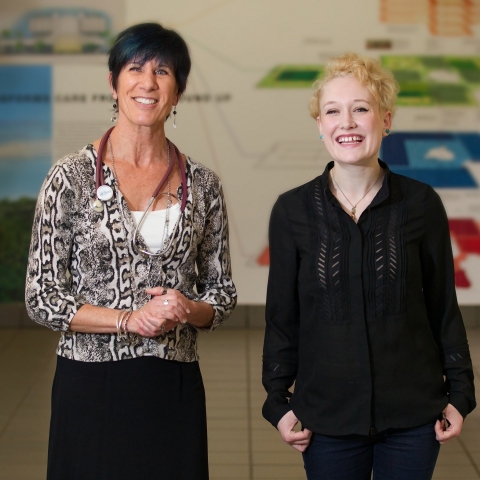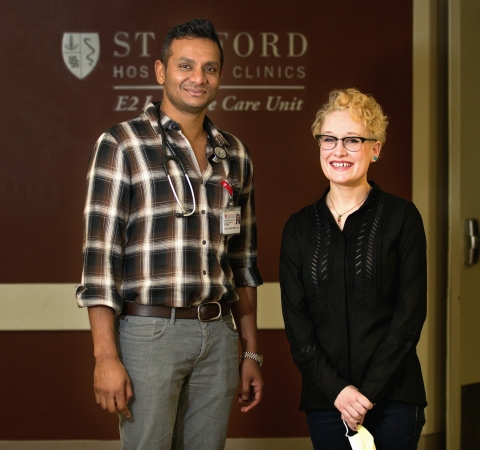STANFORD, Calif.--(BUSINESS WIRE)--Lauren Catron could be considered a poster child for how far medical science has come to promote survival in patients with cystic fibrosis.
At three years old, she was diagnosed with the chronic genetic disease that affects the lungs and the digestive systems – and has no cure. The Santa Clara woman is now 26, a full-time student at Mission College and holds a part-time job.
Catron credits the specialists at the Pulmonary and Cystic Fibrosis Center at Lucile Packard Children’s Hospital Stanford for keeping her alive.
“When I was first diagnosed in 1992, the doctors told my parents that I may not make it to my teens,” said Catron, who has the genotype associated with a shorter lifespan and the most severe symptoms of cystic fibrosis, including a constant buildup of mucus in her lungs that interferes with breathing. “But a whole team of people at Stanford has dedicated themselves to keeping me healthy. They have given me absolute unconditional support, amazing treatment and care, and have become my second family.”
The Center is only one of 20 in the nation, and offers multi-disciplinary care, including respiratory therapy, nutritional counseling, diabetes treatment, psychiatry, and social-work services. It is also the only Cystic Fibrosis Foundation-designated Therapeutic Development Network center in California, Nevada and Oregon, and has cared for patients from as far away as Brazil. At any given time, the program is involved in at least 20 drug studies and 10 other types of trials, ranging from research on how beneficial certain dietary supplements can be in treating the disease to gene therapy.
“No other CF center in California is doing these kinds of clinical trials,” said Carol Conrad, MD, director of the hospital’s pediatric pulmonary function lab and an associate professor at the Stanford University School of Medicine.
An example is a recent study led by Conrad that examined the effect of n-acetylcysteine (NAC), a dietary supplement believed to increase an individual’s antioxidant levels, on CF patients. The results were surprising, according to Conrad. The study looked at 70 patients aged nine to 59 who were randomly given either NAC or a placebo three times a day. Although the supplement didn’t reduce inflammation in the NAC patients’ lungs – Conrad had hoped that by boosting antioxidant stores in the body it would fight swelling and inflammation – it did help patients to maintain baseline lung function during the six months that they took the supplement.
One of the most important medical advances in treating CF coming out of Stanford is the work of Richard Moss, MD, professor of pediatrics and former chief of the Center. In 2002, Moss and a team of researchers were the first to discover that gene therapy may be able to help pulmonary function in cystic fibrosis patients and is one of the future’s most promising life-saving treatments for the disease.
“It’s pretty amazing,” Conrad said. “As depressing as the disease can be, there’s a lot of hope. That’s what keeps us motivated.”
Where once CF patients weren’t expected to live past elementary school, the median life expectancy now is 40, she said. This has led to an important rise in the number of adult CF programs, such as the Cystic Fibrosis Center at Stanford Health Care. Ten years ago, Stanford began recruiting pulmonologists to help treat this population. Catron’s adult care at Stanford is led by Paul Mohabir, MD,
“Lauren’s transition from pediatric to adult care went very smoothly,” said Mohabir, clinical associate professor of pulmonary & critical care medicine at the School of Medicine. “This speaks to great coordination in our continuum of care.”
“It was not until recently that CF patients lived long enough to even need an adult unit,” said Catron, who was referred to the adult side when she was 19 and still receives treatment every two months.
But her years seeing Conrad and the other physicians at Lucile Packard Children’s Hospital gave Catron the tools, specifically home treatments, which are paramount to surviving the deadly disease.
“It takes a lot of buy-in from the patients and their parents,” Conrad said. “We start from day one with an at-home regimen because it’s so vital to treating the disease.”
That’s why every day Catron spends two hours in her home doing breathing exercises and having someone pound on her chest to loosen the thick mucus that collects there. Catron says her boyfriend of four years often helps her with the exercises. In addition to the cystic fibrosis, Catron has CF-related diabetes. So the CF Center taught her how to monitor her carbs while maintaining her weight. Traditionally, CF patients are undernourished.
“Dr. Conrad, Dr. Mohabir and the rest of the team have expectations for me that I feel I have to live up to,” Catron said. “Besides keeping me healthy, they’ve been an amazing resource for what CF patients can do on their own to stay healthy.”
About Stanford Children’s Health and Lucile Packard Children’s Hospital Stanford
Stanford Children’s Health, with Lucile Packard Children’s Hospital Stanford at its core, is an internationally recognized leader in world-class, nurturing care and extraordinary outcomes in every pediatric and obstetric specialty from the routine to rare, for every child and pregnant woman. Together with our Stanford Medicine physicians, nurses, and staff, we deliver this innovative care and research through partnerships, collaborations, outreach, specialty clinics and primary care practices at more than 200 locations in the U.S. western region. As a non-profit, we are committed to supporting our community – from caring for uninsured or underinsured kids, homeless teens and pregnant moms, to helping re-establish school nurse positions in local schools. Learn more about our full range of preeminent programs and network of care at stanfordchildrens.org, and on our Healthier, Happy Lives blog. Join us on Facebook, Twitter, LinkedIn and YouTube.
Lucile Packard Children’s Hospital Stanford is the heart of Stanford Children’s Health, and is one of the nation’s top hospitals for the care of children and expectant mothers. For a decade, we have received the highest specialty rankings of any Northern California children’s hospital, according to U.S. News & World Report’s 2014-15 Best Children’s Hospitals survey, and are the only hospital in Northern California to receive the national 2013 Leapfrog Group Top Children’s Hospital award for quality and patient care safety. Discover more at stanfordchildrens.org.





